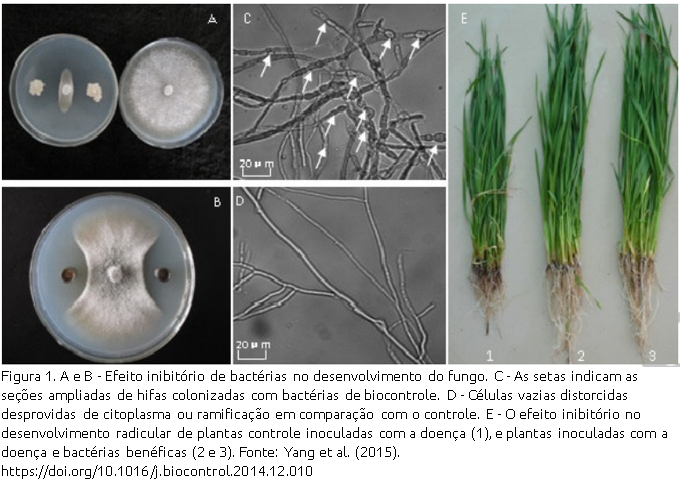Just before the wheat harvest, some care is needed in the implantation of the crop, in order to guarantee the best scenario for its establishment. Due to the areas monitored in the previous harvest, an important management, and little explored, gains prominence: the previous management of areas where there is an incidence of mal-do-pé in wheat.
Wheat foot disease is caused by the fungus Gaeumannomyces graminis var. tritici, which is well adapted to soils with pH around 5.5 and regions with precipitation above 450 mm. This fungus, present in all regions of Rio Grande do Sul, manifests itself in the reproductive phase of the crop, when water usually accumulates and the leaves of infected plants begin to lose their green color. As the infection progresses, the plants turn brown and even die when severely affected.
The symptoms occur in ridges or bands, being easily identified in the roots of pulled plants, where only roots closer to the crown remain adhered and present a black color, since the first roots are deteriorated by the fungus (Figure 1).

A multiplicidade de hospedeiros do fungo (azevém, centeio, sorgo, triticale, trigo, arroz, braquiária, aveia, capins) dificulta o manejo, pois há sempre incentivo para a sobrevivência no patógeno. Contudo, dentre as técnicas de manejo, a rotação de culturas ainda se destaca, indicando-se o uso de plantas não hospedeiras durante no mínimo dois anos, dentre elas: aveia branca, ervilhaca, serradela, canola, tremoço e nabo forrageiro.
Uma alternativa de manejo, visando potencializar a ação de biocontrole incentivada pela rotação, é uso de antagonistas naturais no solo. Bactérias, do gênero Bacillus e Pseudomonas, e fungos, do gênero Trichoderma, atuam liberando compostos antimicrobianos no solo, que afetam o desenvolvimento do fungo no solo, além de competirem nas raízes das plantas, ocupando portas de entrada na planta que seriam locais de colonização para a doença.
Além disso, também existem algumas alternativas biológicas visando o equilíbrio do solo em busca da supressividade.Nesse caso, há um controle natural de patógenos via antibiose (Figura 2), parasitismos, competição, predação e/ou indução de resistência. No tratamento de solo e de sementes, podemos usar tanto promotores de crescimento, quanto agentes de biocontrole, como Bacillus subtillis, Bacillus pumilus, Pseudomonas fluorescens, Bacillus amyloliquefaciens, Trichoderma asperellum, Trichoderma harzianum, entre outros. Esses manejos permitem que, além dos modos de ação baseados em biocontrole, a promoção de crescimento estimule o desenvolvimento vegetal, tornando a planta menos sensível ao ataque do patógeno.

For aerial part management, we have microorganisms that act both with antibiotic action and as colonizers via biofilm, in particular Bacillus subtillis, Bacillus pumillus, Bacillus amyloliquefaciens, Bacillus firmus, Bacillus licheniformis, Bacillus velezensis, in addition to fungi of the genus Trichoderma.
In addition, adequate plant nutrition is a determining factor in tolerance to some pathogens. Well-nourished plants, mainly with nutrients that constitute structures (calcium, magnesium, silicon, potassium, boron, copper, nitrogen and sulfur), tend to better tolerate attacks by pathogens, especially those in the soil.
As in many cultures, the efficient management of foot disease in wheat is the result of a set of agricultural practices, which aims to reduce the interference of the pathogen both in the plant and in the environment, reaching an environmental balance that helps in the biocontrol of the disease. pathogen.
______________________________




